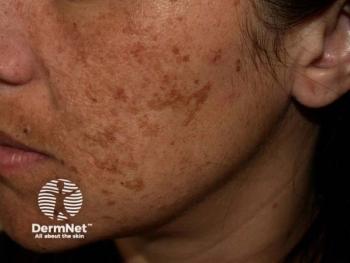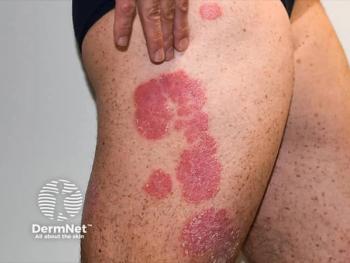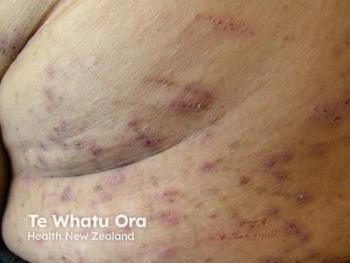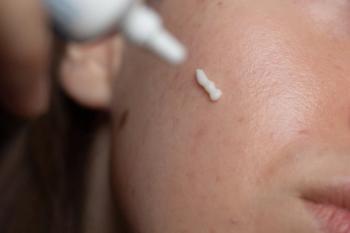
Data Show Spesolimab Maintains Skin Clarity Between GPP Flares
Key Takeaways
- Spesolimab targets the IL-36 receptor, effectively treating GPP by suppressing IL-36–related molecular activity during flares and remission.
- The EFFISAYIL 2 trial sub-study showed spesolimab reduces flare risk by suppressing subclinical inflammation in GPP patients.
Spesolimab effectively targets the IL-36 receptor, reducing inflammation and preventing flares in generalized pustular psoriasis, offering new hope for patients.
Generalized pustular psoriasis (GPP) is driven by unregulated activation of the IL-36 inflammatory pathway in the skin, largely due to genetic mutations in genes such as IL36RN, CARD14, and AP1S3. These mutations contribute to a cascade of pro-inflammatory signals, culminating in the recruitment of neutrophils and pustule formation.1
Spesolimab, a monoclonal antibody that targets the IL-36 receptor, is the first therapy specifically approved for treating GPP. Previous research has shown that spesolimab can rapidly suppress IL-36–related molecular activity during acute GPP flares.2 However, its impact on patients' skin during remission, or nonflare periods, had not been well understood until now.
Recent findings from a biomarker substudy of the phase 2b Effisayil 2 clinical trial (NCT04399837) provide new insights into the role of spesolimab in maintaining disease control between flares.3 Of the 123 participants in the main trial, 18 consented to optional skin biopsies, and 7 provided samples across all time points over the 48-week study period. Based on unsupervised clustering analyses and baseline characteristics, these patients were determined to be representative of the overall cohort.
Results
Among the 7 patients analyzed in depth, 5 did not experience a flare during the study. Of these, 4 received spesolimab at 300 mg subcutaneously every 4 weeks (following a 600-mg loading dose), and 1 received 150 mg every 12 weeks (after a 300-mg loading dose). In contrast, the 2 patients who experienced a flare had received a placebo. At study entry, all patients had a GPP Physician Global Assessment score of 1, indicating almost clear skin, although some still displayed mild signs of inflammation.
Gene expression profiling revealed that 6 of the 7 patients had elevated levels of pro-inflammatory genes at baseline, including those previously identified as IL-36 responsive. Researchers noted that this suggests the presence of ongoing subclinical inflammation even when skin appears nearly clear. These findings were especially notable in patients who had previously received systemic nonbiologic treatments for GPP.
Discussion
Importantly, patients receiving the higher-dose spesolimab regimen demonstrated significant suppression of pro-inflammatory gene signatures by week 48. In fact, 3 of the 4 patients on this regimen showed near-complete normalization of these molecular markers and did not experience flares. These findings indicate that spesolimab not only treats active disease but may also play a critical role in preventing future flares by targeting underlying inflammation.
Interestingly, the presence or absence of mutations in IL36RN, CARD14, or AP1S3 did not appear to influence response to spesolimab or changes in gene expression. Functional studies using CRISPR/Cas9 knockout models of IL36RN and AP1S3 in keratinocytes showed increased sensitivity to IL-17A and IL-36G stimulation, reinforcing the idea that these mutations may contribute to heightened inflammatory responses in affected patients.
This study suggests that patients with GPP harbor residual inflammatory activity in their skin even during clinically inactive periods. Spesolimab maintenance therapy appears effective in suppressing this activity, aligning with the broader results of the Effisayil 2 trial, which demonstrated reduced flare risk with long-term treatment.
Conclusion
Although these findings are promising, the study is limited by its small sample size and the low number of participants with known IL-36 pathway gene mutations. Nonetheless, researchers stated that the results support the use of spesolimab as a maintenance therapy and highlight its potential to modify the course of GPP beyond treating acute flares. They suggested that further large-scale studies are warranted to confirm these findings and optimize treatment strategies for this complex disease.
References
- Bachelez H, Choon SE, Marrakchi S, et al. Inhibition of the interleukin-36 pathway for the treatment of generalized pustular psoriasis. N Engl J Med. 2019;380(10):981-983. doi:10.1056/NEJMc1811317
- Morita A, Strober B, Burden AD, et al. Efficacy and safety of subcutaneous spesolimab for the prevention of generalised pustular psoriasis flares (Effisayil 2): an international, multicentre, randomised, placebo-controlled trial. Lancet. 2023;402(10412):1541-1551. doi:10.1016/S0140-6736(23)01378-8
- Krueger JG, Sarkar MK, Lebwohl MG, et al. Targeting the IL-36 receptor with spesolimab mitigates residual inflammation and prevents generalized pustular psoriasis flares. J Clin Invest. Published online July 1, 2025. doi:10.1172/JCI188530
Newsletter
Like what you’re reading? Subscribe to Dermatology Times for weekly updates on therapies, innovations, and real-world practice tips.


















